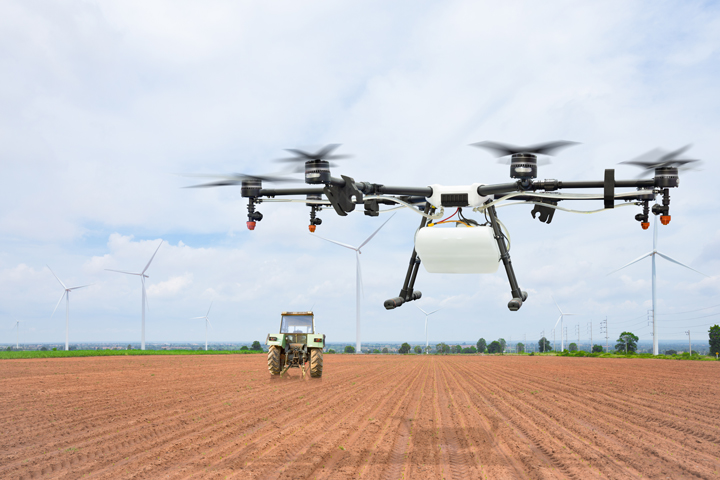The technological advances in agriculture are not just to do with social media savvy cows – the global agricultural robots market was estimated to account for a market revenue of $2,927 million in 2016, but is expected to rocket to $11,050 million in 2023.
Top Article for 2018 - Automating Agriculture: How Automation and Robotics Have Taken to the Fields
Contributed by | EU Automation
Wearable fitness trackers and the Internet of Things (IoT) are two technologies that have become multi-million dollar industries in themselves. Put them together and what do you get? The Internet of Living Things. Here, Jonathan Wilkins, marketing director at obsolete industrial parts supplier, EU Automation, explains how automation is benefiting the farming industry.
Really though, fitness trackers for cows is a blossoming industry. Attaching sensors to cattle can collect biometric data on the health and wellbeing of the animal. According to US start-up HerdDogg, data from the tags can be directly uploaded to Twitter. So technically, there are now tweeting cows.
The technological advances in agriculture are not just to do with social media savvy cows – the global agricultural robots market was estimated to account for a market revenue of $2,927 million in 2016, but is expected to rocket to $11,050 million in 2023. But why is automation spilling out of the automotive, aerospace and electronic sectors and into the agricultural market?
Global challenges
The global population is dramatically increasing. The UN expects the world’s population to hit 8.5 billion by 2030, rising to 9.7 billion by 2050. In order to produce enough food for the 2050 population, the World Bank has forecast that we’ll need to produce 50 per cent more food. With climate change and a skills shortage limiting crop yields, farmers are turning to technology to increase efficiency.

The hand milking of cows, for example, is already becoming rare. New technologies that automate milking can offer benefits for both farmer and animal. Lely, a company in the Netherlands has over 20,000 milking robots across the world, a system which allows cows to choose when they want to be milked, rather than when the farmer decides. The technology attaches and detaches itself, all while collecting data which can be fed back to the farmer. As well as improving efficiency and comfort for the animal, automated technology can work round the clock, to improve outputs and overcome a region’s skills shortage.
As well as producing more food, there is also a pressure on farmers to make processes greener – making the best use of water and cutting down on pesticides. This means that farming must focus on sustainably producing high quality food. Using robots and autonomous vehicles is just one way of doing this.
Advancing existing technology
One staple farming technology, the tractor, is undergoing a technological makeover. Manufacturers including John Deere, CNH Industrial and AGCO are developing driverless tractors. The new machines will be satellite driven, using geopositioning to avoid collisions and make planting decisions.
In unpredictable farming environments, autonomous navigation can be challenging. Greenhouses offer a simpler solution as they can be fitted with tracks and more carefully controlled. In outdoor farming, autonomous vehicles rely on planning and closed-loop control, as well as vision technologies to help the robot to respond to environmental stimuli. Similar to mobile robots in the factory, autonomous devices connect to a central control system to receive instructions and report on status.
Driverless tractors change the role of the farmer from a driver to a fleet manager – an analyst that oversees robots. The new systems are also able to work 24/7 without tiring or stopping, which can increase efficiency.
Drones
One technology helping farmers to do this are drones, or unmanned aerial vehicles, which can be used to image and survey crops, livestock and land. The other common method to achieve this is satellite imaging, usually done at 14 day intervals. Drones open up the possibility to survey crops at any time, which could be the difference between losing and saving an entire crop yield during a pest infestation. Once a problem has been identified, drones can perform crop spraying activities.
Farmers can use infrared drones that track crop health, so that water given to the crops can be adjusted accordingly, helping make the best use of water supplies. In combination with ground sensors, water and nutrients can be measured to trigger the application of fertiliser and irrigation. Incorporating a range of sensors alongside artificial intelligence technology can allow farmers to automate tasks like weed removal.
Harvesting technology
One area which has been difficult to automate is harvesting – fresh fruits and vegetables are delicate, which means they may become bruised by a robot harvest. Industrial robots that are used to moving more robust items must therefore undergo significant changes to be suited to softer items.
One big milestone in this industry took place in September 2017, when the Hands Free Hectare project, a collaboration between Harper Adams University and Precision Decisions, produced the first fully automated harvest. As part of the study, a crop was planted, tended and harvested without a single human entering the field. A tractor and combine harvester were modified to include cameras, lasers and GPS and drones were responsible for monitoring the field while a robot scout assessed the soil.
It was demonstrated at Hannover Messe how the future farm may incorporate a fleet of robots working together. The Mobile Agricultural Robot Swarms (MARS) project, showed how smaller robots can avoid soil compaction and provide continuous operation. In Japan, a stacked automated vegetable factory, which operated inside independent of rainfall or climate, while limiting the space needed for food production.
Technological developments are still required to achieve this level of automation with more delicate crops, but it’s already clear that robotics in the agricultural industry can help overcome the skills shortage and improve monitoring and efficiency. The Internet of Living Things, powered by sensors, can also allow farmers to keep a closer track on their livestock’s wellbeing — they can even find out from their Twitter feed.
EU Automation stocks and sells new, used, refurbished and obsolete industrial automation spares. Its global network of preferred partner warehouses, and wholly owned distribution centers, enables it to offer a unique service within the automation industry, spanning the entire globe. It provides worldwide express delivery on all products meaning it can supply any part, to any destination, at very short notice.
The content & opinions in this article are the author’s and do not necessarily represent the views of AgriTechTomorrow
Comments (0)
This post does not have any comments. Be the first to leave a comment below.
Featured Product

